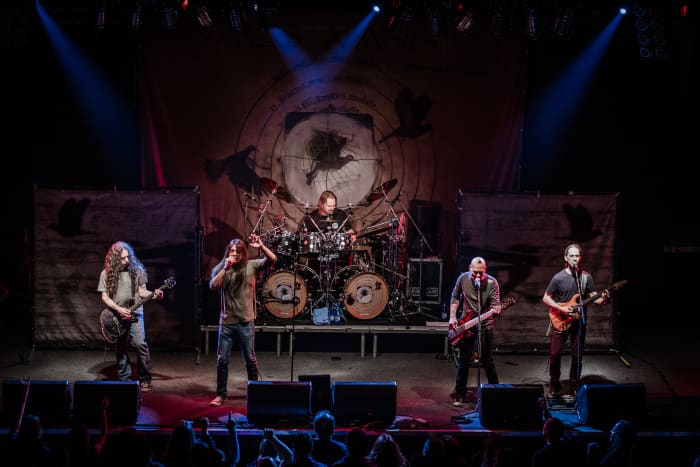100 Best Heavy Metal Bands of the '90s
'90s Metal Bands That Rock
A number of metal subgenres emerged in the '90s, broadening the genre's reach. By branching out and splintering into a number of subgenres, heavy metal has been able to appeal to a wide range of audiences. Earache Records and Roadrunner Records promoted heavy metal bands in a big way throughout the decade.
A number of the metal acts that signed recording deals with these record labels had a great deal of success throughout the decade. Many of the bands that emerged in the late '80s reached the peak of their success in the '90s. In fact, some of the most critically acclaimed metal albums of all time were released during this enigmatic decade.
Many of the heavy metal subgenres that came into prominence in the '90s were instrumental in changing the blueprint for what constituted a metal song. The genre's success in this decade influenced many other forms of extreme music. While heavy metal has evolved throughout each decade, the '90s will be remembered by metal purists for its many trendsetting acts.
The list below showcases a diverse number of '90s heavy metal bands from different subgenres. If you are a heavy metal buff, then you'll definitely have a lot to say. Get vocal with your views and opinions in the comments section.
Top 10 Best Heavy Metal Bands of the '90s
- Pantera
- Sepultura
- Megadeth
- Slayer
- Anthrax
- Motorhead
- Metallica
- Death
- Iron Maiden
- Black Sabbath
Death Metal in the '90s
Death metal was one of the most popular extreme subgenres of heavy metal during this decade. A number of death metal acts that formed in the '80s had considerable success throughout the '90s. Death metal, which evolved from the underground metal movement of the '80s, became a powerful musical entity in the '90s.
The speed and aggression of thrash and hardcore, fused with heavily distorted guitars and double bass drumming, gave death metal its unique identity. A number of Swedish metal bands and Norwegian metal bands came into prominence, offering a more melodic style of death metal. Death growls, death rasps, high-pitched screaming, and death grunts were popular vocal techniques among death metal vocalists in this decade.
#11–20
11. Judas Priest
12. Opeth
13. Guns N’ Roses
14. Tool
15. Type O Negative
16. Dream Theater
Recommended
17. Napalm Death
18. Obituary
19. Slipknot
20. Nine Inch Nails
Black Metal in the '90s
Black metal was another extreme subgenre that rose to prominence in this decade. The second wave of black metal, which emerged in the '90s, was dominated by bands across Europe.
Scandinavia became the epicenter for this form of music. A number of Scandinavian black metal bands reached their peak of popularity in this decade. Tremolo-picked distorted guitars, dark, atmospheric hissing vocals, shrieks, and growls are what gave this subgenre its unique identity.
A number of black metal acts popularized the use of "corpse paint" during their live performances. In fact, satanic themes, including lyrics about ancient paganism, formed the blueprint of this extreme form of music. While the black metal scene was (and continues to be) rampant across Scandinavian countries, throughout the mid-'90s, a slew of black metal bands emerged from Poland, France, and Germany.
Later in the decade, a number of acts associated with the subgenre started incorporating ambient forms of music into their compositions. Symphonic black metal, which took shape in the late '90s, became exceedingly popular with fans of extreme metal.
#21–40
21. Cannibal Corpse
22. Machine Head
23. Rage Against the Machine
24. Soundgarden
25. Testament
26. Queensryche
27. Exodus
28. Deicide
29. Kreator
30. Fear Factory
31. Morbid Angel
32. System of a Down
33. Alice in Chains
34. Korn
35. Venom
36. King Diamond
37. Overkill
38. AC/DC
39. Meshuggah
40. Voivod
Power Metal in the '90s
Power metal, which came into prominence in the mid-'80s, gained a great deal of mainstream popularity in the '90s. A number of power metal bands gained cult followings in Europe, Japan, and South America. Epic, upbeat melodies, fronted by lyrical tales of valor and bravery, are what gives this metal subgenre its unique identity.
Throughout the '90s, power metal became popular with audiences across the globe. Its melodic instrumentation, interspersed with power riffs and flawless high-pitch vocal techniques, had a broad appeal, gaining traction with rock audiences.
Towards the end of the '90s, a number of traditional power metal bands started diversifying their sound by incorporating symphonic elements into their music. Certain acts started employing orchestras and opera singers to help compose their ballads. The textural vocal arrangements and lush ambient soundscapes heard in power metal are what give this bold subgenre its iconic sound.
#41–60
41. Immortal
42. Marilyn Manson
43. Sodom
44. Annihilator
45. Rammstein
46. At the Gates
47. Sarcofago
48. Ministry
49. Kamelot
50. White Zombie
51. Iced Earth
52. Dimmu Borgir
53. Mercyful Fate
54. Carcass
55. Symphony X
56. Danzig
57. Helloween
58. Bathory
59. Children of Bodom
60. Samael
Thrash Metal in the '90s
Thrash metal, which emerged in the early '80s, achieved widespread success in the '90s. Shred leads, combined with low-register guitar riffs, became exceedingly popular in this form of music.
The Bay Area thrash scene played a pivotal role in developing and diversifying the subgenre's sound throughout the '90s. Although the majority of the bands remained in the underground metal movement, certain thrash bands achieved mainstream success.
While the U.S. was the epicenter of thrash in the '80s, the '90s witnessed an explosion of thrash metal acts throughout Europe. German thrash metal bands developed a diverse style that appealed to metal fans across the globe. Thrash lyrics centered around depictions of suffering, death, violence, and the occult.

Most metal bands are "five-piece," with drums, lead guitar, rhythm guitar, bass, and vocals.
Wikipedia Commons
#61–80
61. Deftones
62. Grave
63. Behemoth
64. Therion
65. Stratovarius
66. Fates Warning
67. Burzum
68. Saint Vitus
69. Darkthrone
70. Suicidal Tendencies
71. Candlemass
72. Angra
73. Cradle of Filth
74. Savatage
75. Nightwish
76. Paradise Lost
77. Trouble
78. Katatonia
79. Celtic Frost
80. In Flames
Doom Metal in the '90s
Doom metal was another extreme metal subgenre that came into prominence in the early '90s. Slow tempos, augmented by the brutal assault of low-tuned guitars, are what gave this subgenre its unique identity. Doom metal's crawling guitar riffs and dark lyrics evoked a sense of dread, despair, and impending doom.
While the majority of doom metal bands in the '80s came from the U.S., many European doom metal acts came into prominence in the '90s. These European acts often blended death metal and doom metal together to create what can only be described as a death-doom sound.





